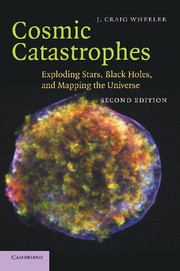Book contents
- Frontmatter
- Contents
- Preface
- 1 Setting the stage: star formation and hydrogen burning in single stars
- 2 Stellar death: the inexorable grip of gravity
- 3 Dancing with stars: binary stellar evolution
- 4 Accretion disks: flat stars
- 5 White dwarfs: quantum dots
- 6 Supernovae: stellar catastrophes
- 7 Supernova 1987A: lessons and enigmas
- 8 Neutron stars: atoms with attitude
- 9 Black holes in theory: into the abyss
- 10 Black holes in fact: exploring the reality
- 11 Gamma-ray bursts, black holes and the Universe: long, long ago and far, far away
- 12 Supernovae and the Universe
- 13 Wormholes and time machines: tunnels in space and time
- 14 Beyond: the frontiers
- Index
8 - Neutron stars: atoms with attitude
Published online by Cambridge University Press: 14 September 2009
- Frontmatter
- Contents
- Preface
- 1 Setting the stage: star formation and hydrogen burning in single stars
- 2 Stellar death: the inexorable grip of gravity
- 3 Dancing with stars: binary stellar evolution
- 4 Accretion disks: flat stars
- 5 White dwarfs: quantum dots
- 6 Supernovae: stellar catastrophes
- 7 Supernova 1987A: lessons and enigmas
- 8 Neutron stars: atoms with attitude
- 9 Black holes in theory: into the abyss
- 10 Black holes in fact: exploring the reality
- 11 Gamma-ray bursts, black holes and the Universe: long, long ago and far, far away
- 12 Supernovae and the Universe
- 13 Wormholes and time machines: tunnels in space and time
- 14 Beyond: the frontiers
- Index
Summary
HISTORY – THEORY LEADS, FOR ONCE
In 1932, the brilliant Russian physicist Lev Landau argued on general grounds that the newly discovered quantum pressure could not support a mass much in excess of 1 solar mass. He addressed his discussion to electrons, but the type of particle did not matter. In 1933, the neutron was discovered, after Landau's paper had been submitted. In retrospect, Landau's arguments applied to the quantum pressure of neutrons as well. An object supported by the quantum pressure of neutrons should be smaller and denser than a white dwarf, but it should have nearly the same maximum mass, about 1 solar mass.
Fritz Zwicky of Caltech was one of the world's first active supernova observers. Quick on the pickup, Zwicky suggested in 1934 that supernovae result from the energy liberated in forming a neutron star. Not until a year later, in 1935, did the precocious young Indian physicist, Subramanyan Chandrasekhar, present his rigorous derivation of the nature of the quantum pressure and the mass limit to white dwarfs that bears his name.
Robert Oppenheimer made history with his leadership of the Manhattan Project, but among his most widely known papers are two published with students in 1939. The first of these papers used the complete theory of general relativity for the first time to estimate the upper mass limit of neutron stars to be 0.7 solar mass. The second paper explored the result of violating that limit with the resulting production of a black hole.
- Type
- Chapter
- Information
- Cosmic CatastrophesExploding Stars, Black Holes, and Mapping the Universe, pp. 141 - 175Publisher: Cambridge University PressPrint publication year: 2007



